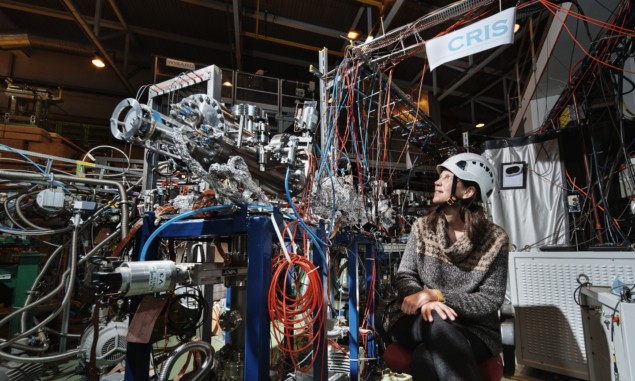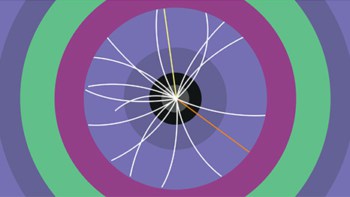
The nuclear shell model of the atomic nucleus, more than 70 years old, stays firmly in place now that researchers from CERN’s nuclear physics facility ISOLDE have shown that the series of magic numbers of nucleons does not need an update. However, their result joins a list of contradictory studies of nuclei with around 32 neutrons, which continue to puzzle physicists.
Atomic nuclei are called magic if their nucleon shells – similar to the orbitals of atomic electrons – are completely occupied by protons or neutrons. Magic nuclei are more stable against radioactive decay than their neighbors, even if they live in an exotic, very neutron-rich or proton-rich region of the chart of nuclides. Complete shells correspond to the magic numbers 2, 8, 20, 28, 50, 82 and 126. When both the numbers of protons and neutrons are magic, a nucleus is even more stable – and labeled doubly magic.
In the past two decades several experiments have hinted towards a new magic number, at least for neutrons, at N=32 (N and Z signify the numbers of neutrons and protons respectively in a nucleus). In 2013, while exploring neutron-rich calcium isotopes, the ISOLTRAP mass spectrometer at CERN revealed a sudden drop in the two-neutron separation energy of isotopes beyond N=32, which is an experimental signature for a magic number. Earlier studies of the excitation spectrum of calcium-52, also at ISOLDE, found a higher excitation energy than expected, which also is a signature for a double magic nucleus (Z=20, N=32). Furthermore, researchers from the Radioactive Ion Beam Factory at RIKEN in Japan found similar hints, not only for calcium-52 but more recently also for calcium-54 (N=34).
Charge radius
However, determination of the charge radius – a measure of the nucleus’ size – of potassium-51 and calcium-52 (both having 32 neutrons) did not show any decrease, as would be expected if doubly magic nuclei. An international group of physicists saw this in measurements previously done at CERN’s nuclear physics facility ISOLDE, which produces beams of exotic radioactive particles. Now, the researchers have looked at the very exotic potassium-52 (N=33). The goal was to check for a sudden relative increase in radius, which is another powerful indication for a magic neutron number of 32. Again, a negative result was found.
The new results challenge current nuclear theories. “We don’t refute the outcomes of the earlier experiments, as these were done in the right way and with the best equipment available,” says Thomas Cocolios, a nuclear physicist at the KU Leuven in Belgium and member of the ISOLDE team. “But we do question the claims that those experiments would have showed the existence of a new magic number for neutrons.”
Now the ISOLDE researchers plan to perform similar measurements for calcium-53 and calcium-54, so that they can also check a N=34 magic number claim.
Last year other teams at ISOLDE showed that the established magic numbers are preserved in heavy exotic, extremely short-living nuclei like nickel-78 or tin-132, which are doubly magic and form islands of relative stability. However. in lighter nuclei this is not always the case, like in the hypothetically but non-existing oxygen-28. “But this is an extreme example,” says Cocolios, “with more than twice as many neutrons than protons.”
Sub-shell closing
The observation that while crossing N=32, the energies of the isotopes point towards magic behaviour, but not the charge radius, is something theorists will have to resolve. “They support a sub-shell closing at 32 neutrons,” says Gerda Neyens, a nuclear physicist at the KU Leuven and ISOLDE’s head of physics research. Nuclear sub-shells are analogous to the familiar atomic sub-shells for electrons. “We see a contradiction between the interpretation of experiments that all provide reliable results, and the consistent interpretation of all observables in theoretical models. This is a call for action for the theorists.”

Biggest expansion of known chemical universe targeted by FRIB nuclear facility
Indeed, the researchers worked together with theorists to analyse the data using state-of-the-art models, finding that the data only challenge these. They report their results in a paper in Nature Physics and lead author Ági Koszorús, formerly at Leuven, comments, “The best models on the market cannot reproduce the data in a satisfactory way”.
According to Neyens, the theoretical models have difficulties because the strong interaction that keeps protons and neutrons together does not act directly on them, but at the sub-nucleon level, on the quarks. Cocolios adds: “This hinders our understanding of atomic nuclei, especially exotic ones. The more we study exotic nuclei, the more we realize that the models have difficulties to reproduce all experimental results in a coherent way”.



